
Hesperocyparis bakeri, previously known Cupressus bakeri, with the common names Baker cypress, Modoc cypress, or Siskiyou cypress, is a rare species of western cypress tree endemic to a small area across far northern California and extreme southwestern Oregon, in the western United States.

Malacothrix is a genus of plants in the tribe Cichorieae within the family Asteraceae. They are known generally as desert dandelions or desertdandelions. Most are native to western North America although a few have been introduced to South America. Several are found only on offshore islands in the Pacific.
Streptanthus flavescens, synonyms including Guillenia flavescens, is a species of mustard plant in the family Brassicaceae. It is one of several species known by the common name yellow mustard, though the plant most widely known as yellow mustard is probably Sinapis alba. S. flavescens is a thin-stemmed annual herb growing large, lobed or toothed leaves up to 22 centimeters long around its base, and smaller, less toothed leaves along its gray-pink to brown stem. At intervals along the upper stem appear cream, yellowish, or very pale purple flowers, each somewhat cuboid in shape and about a centimeter long. The tips of the petals around the mouth are curled, flared, or claw-like. The fruit is a thin silique up to 9 centimeters long. This species is endemic to California, where it grows in the valleys and mountains surrounding the San Francisco Bay Area.
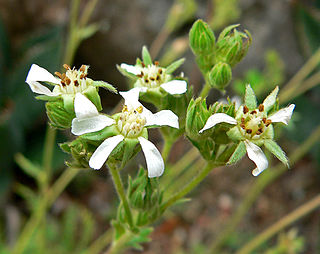
Potentilla clevelandii, also known as Cleveland's horkelia, is a species of flowering plant in the rose family. It is native to the Peninsular Ranges of southern California and northern Baja California.

Potentilla daucifolia, commonly known as carrotleaf horkelia, is a species of flowering plant in the rose family. It is native to the Klamath Mountains and surrounding ranges in northern California and southern Oregon. It grows on mountain slopes and fields, often on serpentine soils.
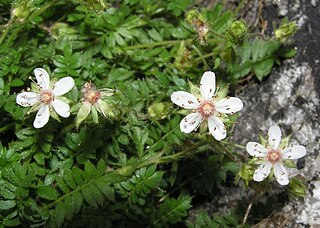
Potentilla callida, commonly known as Tahquitz mousetail, is a rare species of flowering plant in the rose family.

Potentilla muirii, commonly known as granite mousetail, is a species of flowering plant in the rose family. It is endemic to the High Sierra Nevada of California, where it grows on rocky slopes and cliffs.

Sairocarpus cornutus, synonym Antirrhinum cornutum, is an uncommon species of New World flowering plant in the family Plantaginaceae, known by the common name spurred snapdragon.

Malacothrix incana is an uncommon species of flowering plant in the family Asteraceae known by the common name dunedelion. This species is a mounding shrub with wooly leaves. It is endemic to California, where it grows only in sand dunes on the beaches of the Channel Islands and isolated spots along the mainland coastline in San Luis Obispo and Santa Barbara Counties. Malacothrix incana was first collected in San Diego, far south of its present range, but the plant is now extirpated from there.
Malacothrix indecora is a rare species of flowering plant in the family Asteraceae known by the common name Santa Cruz Island desertdandelion. It is endemic to the Channel Islands of California, where it is known from only a few populations on three of the eight islands. As of 2000, there were three occurrences on San Miguel Island, two on Santa Rosa Island, and one on Santa Cruz Island. It grows on the bluffs and rocky coastal grasslands of the islands. Like many Channel Islands endemics, this plant is naturally limited in distribution and has been threatened by the presence of destructive introduced mammals, in this case, feral pigs. The plant became a federally listed endangered species in 1997. This is a mat-forming annual herb which spreads low to the ground no more than about 10 centimeters high. The fleshy leaves have dull lobes. The inflorescence is an array of flower heads lined with oval-shaped phyllaries. The ray florets are under a centimeter long and yellow in color.
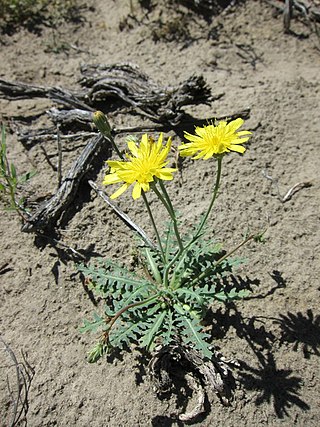
Malacothrix sonchoides is a species of flowering plant in the aster family known by the common names sowthistle desertdandelion and yellow saucers. It is native to much of the western United States, where it grows in sandy substrates in habitat such as Joshua tree woodland, grassland, creosote bush scrub, and ephedra-blackbrush communities.
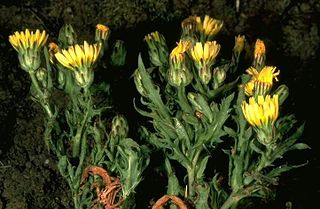
Malacothrix squalida is a rare species of flowering plant in the family Asteraceae known by the common name Santa Cruz desertdandelion. It is endemic to Santa Cruz and Anacapa Islands, two of the eight Channel Islands of California, where it grows on rocky seaside bluffs and cliffs. The plant is very limited in distribution and today exists only in degraded habitat on these two small islands. It was last collected from Santa Cruz Island in 1968, and two populations were noted on Anacapa Island in 1998; in drought years there may be no plants at all. It became a federally listed endangered species in 1997. This is an annual herb growing a hairless, waxy stem 20 to 30 centimeters in maximum height. The leaves are sharply lobed. The inflorescence is an array of flower heads lined with oval-shaped phyllaries. The ray florets are 1 to 2 centimeters and light yellow in color.

Diplacus clevelandii is an uncommon species of monkeyflower known by the common name Cleveland's bush monkeyflower. It was formerly known as Mimulus clevelandii.

Sabulina rubella is a species of flowering plant in the family Caryophyllaceae known by several common names, including beautiful sandwort, mountain sandwort, Arctic sandwort, and boreal stitchwort. It has a circumboreal distribution, occurring throughout the northernmost Northern Hemisphere from the Arctic Circle on the Arctic tundra into the alpine climates of mountainous areas in temperate Eurasia and North America. It grows in rocky, moist, often barren habitat, including gravelly, sparsely vegetated slopes with little organic matter. It is a calciphile, growing in calcareous substrates such as soils rich in decomposed limestone.
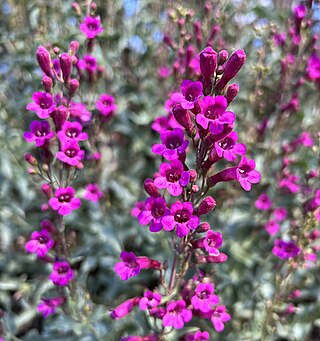
Penstemon clevelandii is a species of penstemon known by the common name Cleveland's beardtongue. It is native to southern California and Baja California, where it grows in mountain and desert habitat such as scrub, woodland, and chaparral. It is a perennial herb with upright, branching stems 70 centimeters in maximum height. The thick leaves are oval in shape, sometimes toothed, and 2 to 6 centimeters in length. The inflorescence produces tubular flowers with expanded, lipped mouths. The flower is pink to magenta in color, up to 2.4 centimeters in length, and somewhat glandular on the outer surface.
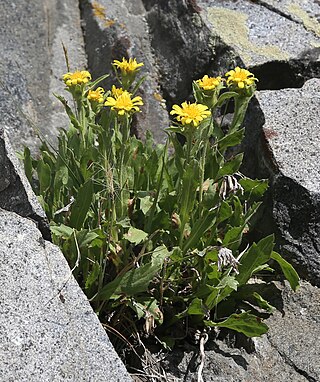
Tonestus peirsonii is a local-endemic species of flowering plant in the family Asteraceae known by the common names Inyo tonestus, Peirson's serpentweed and Peirson's tonestus.
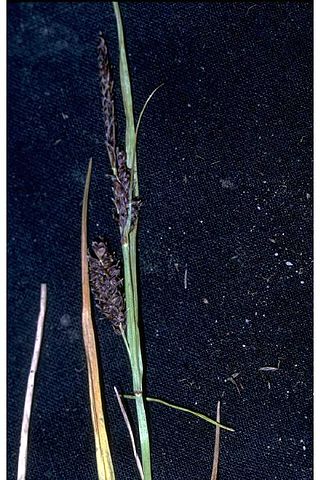
Carex saxatilis is a species of sedge known by the common names rock sedge and russet sedge.
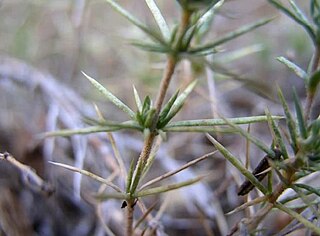
Linanthus watsonii is a species of flowering plant in the phlox family known by the common name Watson's prickly phlox. It is native to the western United States, where it occurs in Colorado, Idaho, Nevada, Utah, and Wyoming.
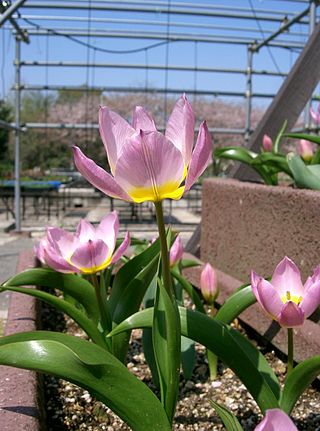
Tulipa saxatilis is a Greek and Turkish species of plant in the genus Tulipa of the family Liliaceae.

Oreojuncus trifidus is a species of rush known by the common names highland rush and three-leaved rush. It is native to the Northern Hemisphere, where it is an arctic/montane species with an amphi-atlantic distribution.


















